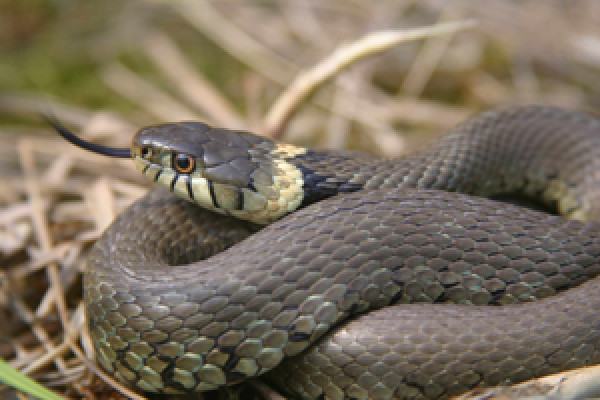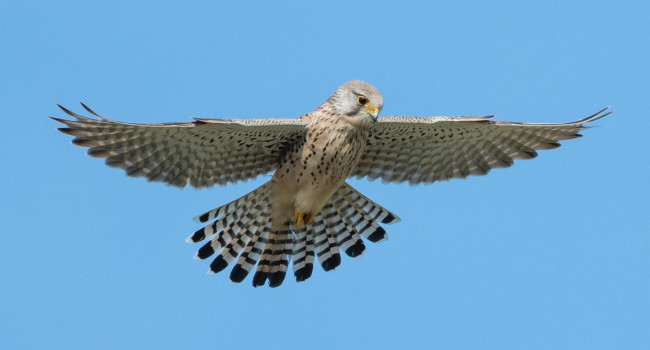Grass Snake

Natrix natrix
There is a tendency for casual observers to misidentify a Grass Snake, fearing that it is actually an Adder. However, the two species (in their normal colour forms) are quite different in appearance. A fully-grown adult Grass Snake may be more than a metre in length and is typically a medium olive green or grey above, with a series of regular small black markings along the side.
The yellow and black collar markings are distinctive and any snake seen in Britain with such markings will be a Grass Snake. Some individuals, though, lack these markings but the general body pattern, large size and round pupil to the eye should still be distinctive. Complete melanism is rare and has not, to my knowledge, been reported in Britain (melanism is more frequently reported in the Adder).
Grass Snakes typically emerge from hibernation in March or April and spend the first few days close to the hibernaculum. They will then move away in search of food and a mate, with mating itself taking place in April or May.
As its name suggests, the Grass Snake favours damp areas with long grass, often close to water. Grass Snakes will cover significant distances in search of suitable hibernation sites or feeding areas and may sometimes be found in gardens or parks. Sheltered garden ponds provide a useful hunting ground during spring as individuals who recently emerged from hibernation seek out frogs and their tadpoles.
Grass Snakes have more predators than you might think. The list is long but it includes herons, Hedgehogs and Weasels.
The Grass Snake is protected under the Wildlife and Countryside Act 1981.
Females seek out nest sites where warmth is generated artificially by the surroundings. Manure and compost heaps, together with piles of rotting leaves or reeds, are ideal and it is into these that between 30 and 40 eggs are laid during June or July. Young females lay fewer eggs (typically 8-10). The eggs are deposited over a 10-12 hour period, the first few eggs being laid in quick succession, with a greater interval elapsing between the last few eggs to be laid. Depending upon the temperature, the young emerge from the eggs after some ten weeks (August-September) and are about the same length and girth as a pencil.
Grass Snakes follow a seasonal diet. In the spring, they take fish when they are spawning and are easier to catch. During the summer, they favour newts for the same reason. From July onwards, they move on land catching mostly frogs and toads. They do catch mice and voles, but only on rare occasions.
Although the Grass Snake rarely bites, it can put on a seemingly aggressive defence if cornered, inflating the body, hissing loudly and striking with the mouth closed. On occasion, an individual will adopt a completely different form of defence by feigning death. This very convincing display involves the snake writhing onto its back, the body becoming flaccid and the mouth open with the tongue hanging out. If further provoked or caught, they will struggle violently and discharge an evil-smelling fluid from their vent.






Share this page